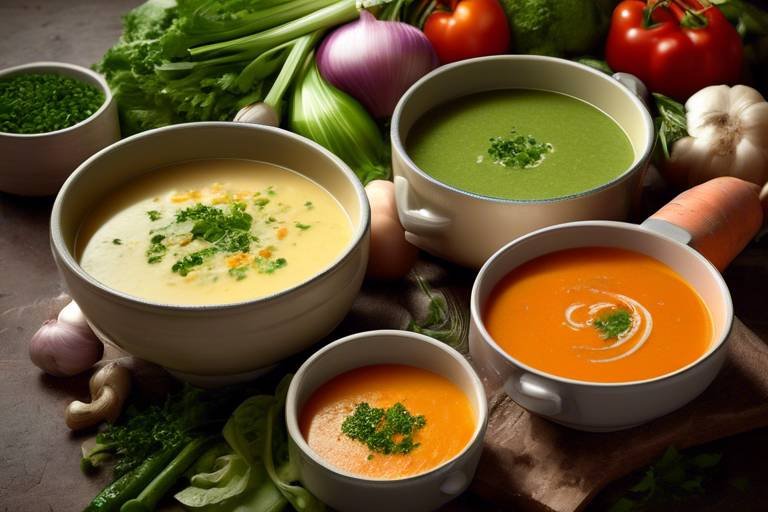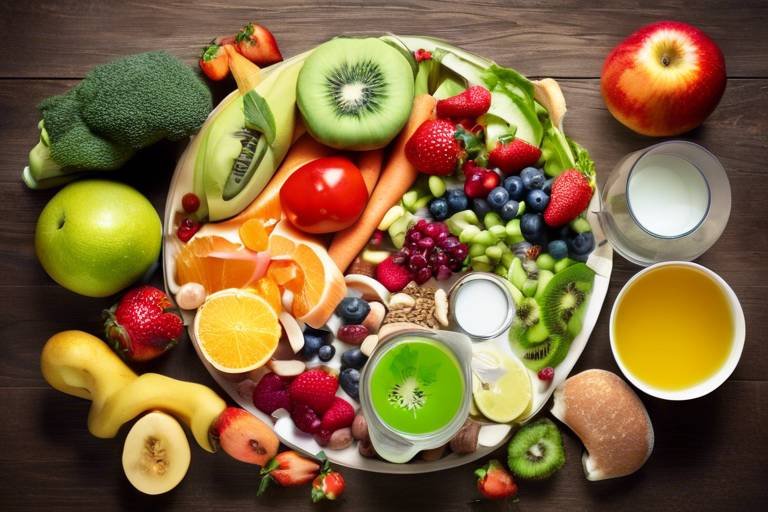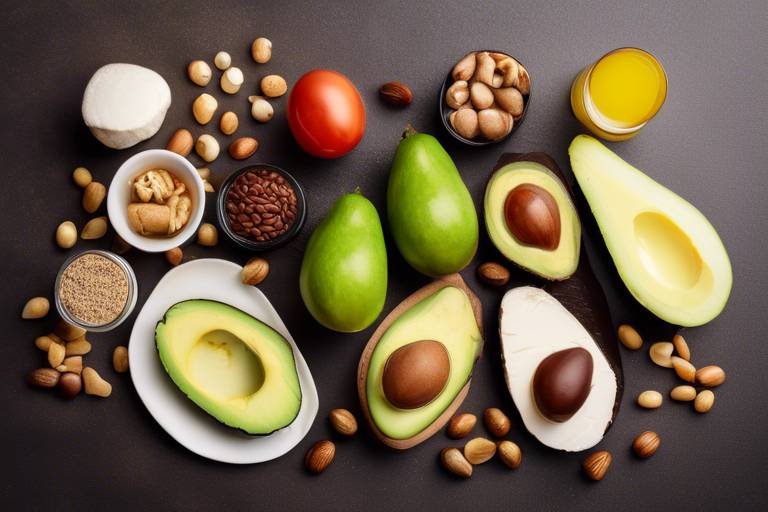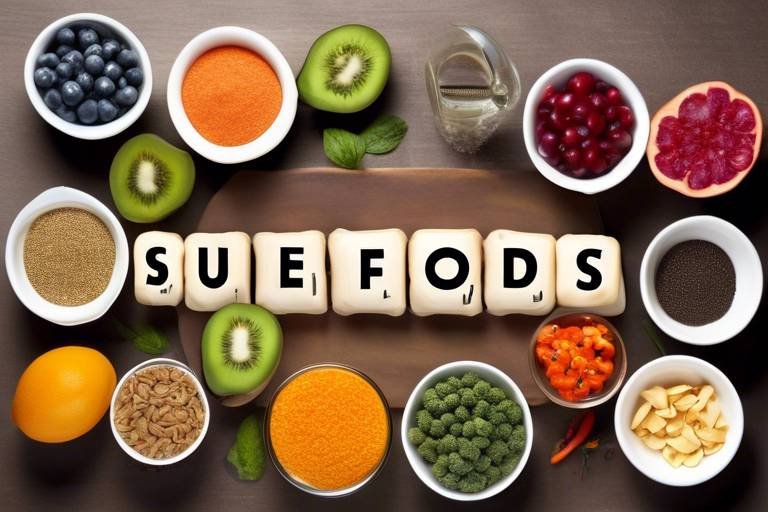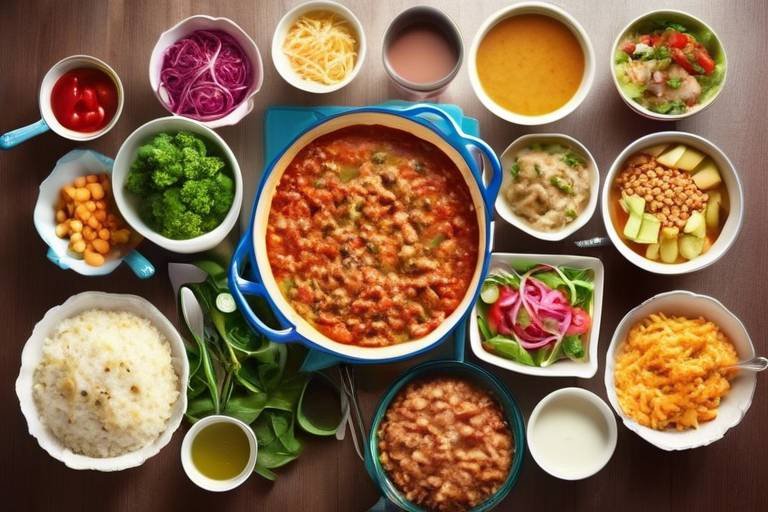Making Nutrient-Dense Soups for Your Family
In today's fast-paced world, we often find ourselves juggling between work, family, and personal time, which can make it challenging to prepare healthy meals. However, one of the easiest ways to ensure your family is consuming nutrient-dense foods is by making delicious soups. Not only are soups comforting and satisfying, but they can also be packed with a variety of vitamins, minerals, and other essential nutrients. Imagine a warm bowl of soup on a chilly evening, filled to the brim with fresh vegetables, hearty proteins, and aromatic spices. It’s not just food; it's a hug in a bowl!
Creating nutrient-dense soups is all about the ingredients you choose and the methods you employ. By selecting fresh, high-quality ingredients, you can elevate a simple soup into a nutritional powerhouse. Think of your soup as a canvas where you can paint with flavors and colors, using seasonal vegetables, wholesome grains, and lean proteins. Whether it’s a vibrant carrot and ginger soup or a hearty lentil stew, the possibilities are endless.
Moreover, soups are incredibly versatile. They can cater to various dietary needs, whether you're looking for vegetarian options, gluten-free choices, or protein-rich meals. The beauty of soup-making lies in its simplicity; you can easily adapt recipes based on what you have in your pantry. So, roll up your sleeves and let’s dive into the world of soup-making that not only nourishes your family but also delights their taste buds!
When it comes to making nutrient-dense soups, the first step is selecting the right ingredients. Fresh, seasonal produce is always your best bet. Vegetables like spinach, kale, carrots, and zucchini not only add flavor but also provide a wealth of nutrients. Incorporating proteins such as beans, lentils, or lean meats can turn your soup into a fulfilling meal. Don’t forget about grains like quinoa or barley, which can add texture and additional nutritional benefits.
Here’s a quick look at some ingredients that can elevate your soup game:
| Ingredient | Nutritional Benefit |
|---|---|
| Spinach | Rich in iron and vitamins A, C, and K |
| Lentils | High in protein and fiber |
| Carrots | Excellent source of beta-carotene |
| Quinoa | Complete protein and gluten-free |
By focusing on these ingredients, you can create soups that are not only tasty but also incredibly nourishing for your family.
Once you have your ingredients ready, the next step is to think about your cooking techniques. Each method can bring out different flavors and textures in your soup. For instance, sautéing your vegetables in a bit of olive oil before adding them to the pot can enhance their sweetness and depth. Simmering allows the flavors to meld together beautifully, creating a harmonious blend of tastes. And don’t underestimate the power of roasting your vegetables beforehand; it can add a delightful caramelization that takes your soup to the next level.
The foundation of any great soup lies in its flavor base. Aromatics like onions, garlic, and fresh herbs are essential for developing depth and richness. Start by sautéing onions and garlic until they are translucent, then add your other ingredients. This simple step can make a world of difference in the final taste of your soup.
Speaking of flavor, have you ever tried making your own broth? Homemade broths are a game-changer. They are not only healthier than store-bought versions, which can be high in sodium and preservatives, but they also allow you to control the flavors. You can simmer leftover bones, vegetables, and herbs to create a rich, nutrient-dense base for your soups. Trust me, once you go homemade, you’ll never look back!
Spices and herbs are the secret weapons in your soup arsenal. They add flavor and, believe it or not, can boost the nutritional content of your dish. For example, turmeric is known for its anti-inflammatory properties, while cumin can aid digestion. Experiment with different combinations to find what works best for your palate. A pinch of this and a dash of that can transform your soup from bland to grand!
To create a well-rounded soup, it’s important to balance proteins, carbohydrates, and fats. Think of it like a symphony where each ingredient plays its part perfectly. Adding protein-rich ingredients like beans or chicken, along with healthy fats from olive oil or avocado, ensures that your soup is not only delicious but also satisfying. This balance keeps everyone in the family happy and full!
Now that you have a solid understanding of ingredients and techniques, it's time to get creative! Here are a few nutrient-dense soup ideas to inspire you:
- Hearty Vegetable Soup: Packed with seasonal veggies and a splash of lemon juice for brightness.
- Spicy Black Bean Soup: A protein-packed option with a kick of jalapeño and topped with avocado.
- Chicken Quinoa Soup: A comforting blend of chicken, quinoa, and fresh herbs.
Using seasonal ingredients not only enhances the flavor of your soups but also ensures that you are getting the freshest produce available. In the fall, think of using pumpkin, while spring can bring in fresh peas and asparagus. Each season offers a unique palette of flavors that can elevate your soup-making game.
Lastly, let's talk about how to store your delicious creations. Proper storage techniques can help maintain the quality and nutrients of your soups. Allow your soup to cool completely before transferring it to airtight containers. You can freeze individual portions for quick meals later on. Just remember to label them with the date and contents, so you can easily find your favorites when hunger strikes!
Q: Can I make soups ahead of time?
A: Absolutely! Soups often taste better the next day as the flavors meld together. Just store them in the fridge or freezer for later use.
Q: What can I do if my soup is too salty?
A: If your soup turns out too salty, try adding a peeled potato while it simmers. The potato will absorb some of the saltiness.
Q: How long can I store homemade soup?
A: Homemade soup can be stored in the refrigerator for about 3-4 days. If you freeze it, it can last for up to 3 months.

Choosing the Right Ingredients
When it comes to making nutrient-dense soups, the foundation lies in your choice of ingredients. Think of ingredients as the building blocks of your soup; the better the blocks, the stronger the structure! Fresh, high-quality ingredients not only enhance the flavor but also pack your soup with essential vitamins and minerals. So, what should you look for? Let’s dive into the world of vegetables, proteins, and grains that will elevate your soup game to a whole new level.
First things first, let’s talk about vegetables. They are the stars of your soup, providing color, texture, and a wealth of nutrients. Go for a variety of colors to ensure a range of nutrients. For example:
- Leafy greens like spinach or kale are rich in iron and vitamins A and C.
- Root vegetables such as carrots and sweet potatoes add sweetness and fiber.
- Cruciferous veggies like broccoli and cauliflower bring antioxidants to the table.
Next up, let’s not forget about proteins. They are essential for a well-rounded meal, providing the necessary building blocks for our bodies. You can choose from:
- Legumes like lentils and beans, which are packed with protein and fiber.
- Meats such as chicken, beef, or turkey for a hearty and satisfying soup.
- Tofu or tempeh for a plant-based protein option that absorbs flavors beautifully.
Now, let’s sprinkle in some grains. They add bulk and heartiness to your soup, making it more filling. Options like quinoa, barley, or brown rice not only provide carbohydrates but also contribute to the soup's texture. Each grain brings its own unique flavor and nutritional benefits, so don’t hesitate to experiment!
Lastly, consider the seasonality of your ingredients. Using seasonal produce means you’re likely to find fresher and more flavorful options. For instance, in the fall, you might want to use squash and root vegetables, while spring could bring you fresh peas and asparagus. By aligning your soup ingredients with the seasons, you not only enhance the taste but also support local farmers and reduce your carbon footprint.
In summary, choosing the right ingredients is about more than just flavor; it’s about creating a nutritional powerhouse in a bowl. By focusing on fresh vegetables, quality proteins, and wholesome grains, you can craft soups that nourish both the body and soul. So, next time you’re in the kitchen, remember: the right ingredients can turn a simple soup into a nutrient-dense delight!

Cooking Techniques for Flavor
When it comes to crafting the perfect soup, the cooking techniques you employ can make all the difference. Think of your soup as a blank canvas; the methods you choose to apply will help shape the final masterpiece. One of the most effective techniques is sautéing. By starting with a hot pan and a splash of oil, you can quickly cook down your aromatics like onions and garlic, releasing their essential oils and enhancing their natural sweetness. This step is crucial because it lays the foundation for a deeply flavored broth.
Another technique that deserves a spotlight is simmering. This gentle cooking method allows flavors to meld together beautifully over time. Imagine a pot of simmering goodness on your stove, filling your kitchen with an irresistible aroma. When you bring your ingredients to a boil and then reduce the heat, you're inviting all those flavors to dance together, creating a harmonious blend that is hard to resist. The longer you simmer, the richer and more complex your soup will become. Just remember, patience is key!
Don’t overlook the power of roasting your vegetables before adding them to your soup. Roasting caramelizes the natural sugars in the ingredients, imparting a depth of flavor that boiling simply can’t achieve. Picture biting into a soup filled with roasted carrots and sweet potatoes; the taste is like a warm hug on a chilly day. Just toss your veggies in a bit of oil, sprinkle some salt, and let the oven work its magic before tossing them into your pot.
As you explore these cooking techniques, consider how they can be combined for even greater effect. For instance, you might sauté your aromatics, add in roasted vegetables, and then simmer everything together in a rich broth. This layered approach not only builds flavor but also adds texture to your soup. The result? A bowl of comfort that is both delicious and nutrient-dense.
To summarize, here’s a quick comparison of the techniques discussed:
| Technique | Description | Benefits |
|---|---|---|
| Sautéing | Cooks aromatics quickly in a hot pan | Enhances sweetness and releases essential oils |
| Simmering | Gently cooks ingredients over low heat | Allows flavors to meld and develop complexity |
| Roasting | Cooks vegetables in the oven until caramelized | Imparts a rich, deep flavor |
By mastering these techniques, you'll not only elevate the taste of your soups but also ensure that they are packed with flavor and nutrition. So, next time you gather your ingredients, remember that the way you cook them is just as important as what you choose to put in the pot!
Q: Can I use frozen vegetables in my soup?
A: Absolutely! Frozen vegetables can be a great time-saver and still retain a lot of their nutrients. Just be sure to add them during the last part of the cooking process to avoid overcooking.
Q: How do I know when my soup is done?
A: Taste is your best guide! Soup is generally ready when all ingredients are tender and the flavors have melded together. If you’re using meat, ensure it’s fully cooked through.
Q: Can I make soup in advance?
A: Yes, making soup ahead of time is a great idea! In fact, many soups taste even better the next day after the flavors have had time to develop. Just store it in an airtight container in the fridge.

Building a Flavor Base
Creating a solid flavor base is essential for any soup. Think of it as the backbone of your dish, the sturdy framework that supports all the deliciousness to come. When you start with a robust flavor foundation, every ingredient you add afterward will shine brighter. So, how do we build this flavor base? The answer lies in the power of aromatics. Ingredients like onions, garlic, and a variety of herbs are your best friends in this culinary journey.
Start by finely chopping onions and garlic. These two ingredients are like the dynamic duo of flavor; they complement each other perfectly and create a wonderful aroma that fills your kitchen. Sauté them in a splash of olive oil over medium heat until they become translucent and fragrant. This process not only softens them but also releases their natural sugars, adding a subtle sweetness to your soup.
Next, consider adding a mix of herbs. Fresh herbs such as thyme, rosemary, or even a hint of basil can elevate your soup to new heights. If you're using dried herbs, remember that they are more concentrated, so you’ll need less. A good rule of thumb is to use about one-third of the amount of dried herbs compared to fresh. Throw in a bay leaf or two while your soup simmers for an extra layer of flavor. Just don’t forget to fish them out before serving!
Once your aromatics are sautéed to perfection, it’s time to add your liquid. This could be water, vegetable broth, or homemade stock, which we’ll dive into later. The key here is to let your flavor base simmer gently, allowing all those lovely flavors to meld together. As the soup cooks, you’ll notice how the aroma transforms, inviting everyone in your home to gather around the table.
Incorporating a pinch of salt at this stage is crucial. It helps to draw out the flavors of the aromatics and enhances the overall taste of your soup. However, be cautious; you can always add more salt later, but you can’t take it away once it’s in! Balancing flavors is an art, and you’ll become a master with practice.
In summary, building a flavor base is about layering flavors and creating depth. It’s like painting a masterpiece; each stroke contributes to the final image. So, next time you whip up a batch of soup, remember to take your time with the aromatics. They are the unsung heroes of your dish, and with a little love and attention, they will transform your soup from ordinary to extraordinary!
- What are the best aromatics to use for soups? The best aromatics include onions, garlic, carrots, and celery, often referred to as the "mirepoix." Fresh herbs like thyme and parsley also add great flavor.
- How long should I sauté the aromatics? Sauté the aromatics for about 5-10 minutes until they are soft and fragrant, but be careful not to burn them!
- Can I use store-bought broth instead of homemade? Yes, store-bought broth is a convenient option, but homemade broth typically offers a richer flavor and more nutrients.

Using Homemade Broths
When it comes to making nutrient-dense soups, homemade broths are a game changer. Imagine the difference between a store-bought broth that’s often loaded with preservatives and a rich, savory stock simmered for hours in your own kitchen. Not only does homemade broth elevate the flavor of your soups, but it also packs a nutritional punch that pre-packaged options simply can't match. You might wonder, why should I go through the effort? The answer lies in the depth of flavor and the health benefits that come from using fresh ingredients.
One of the primary advantages of homemade broth is that you have complete control over what goes into it. You can choose high-quality bones, fresh vegetables, and aromatic herbs, ensuring that every spoonful is bursting with flavor and nutrients. For instance, using organic chicken bones can provide essential amino acids, while adding vegetables like carrots, celery, and onions not only enhances the taste but also contributes vitamins and minerals.
Making your own broth is also an excellent way to reduce food waste. You can use leftover vegetable scraps or bones from previous meals, turning what would be waste into a delicious base for your soups. Plus, it’s a simple process! Just toss your ingredients into a pot, cover with water, and let it simmer for several hours. The longer you let it cook, the more flavors are extracted. You can also use a slow cooker or an Instant Pot for convenience.
Here’s a quick overview of how to make a basic homemade broth:
| Ingredients | Preparation Steps |
|---|---|
|
|
After your broth is prepared, you can use it immediately in your soups or store it for later use. Just imagine having a jar of homemade broth waiting in your fridge, ready to be transformed into a delicious soup at a moment’s notice! This not only saves you time but also ensures that you’re always prepared for a healthy meal.
In conclusion, using homemade broths is an easy and rewarding way to enhance your soups. The flavor, nutrition, and satisfaction of creating something from scratch are well worth the effort. So, the next time you’re about to make soup, consider reaching for your own homemade broth instead of the store-bought variety. Your taste buds and your family will thank you!
Q: How long can I store homemade broth?
A: Homemade broth can be stored in the refrigerator for up to 5 days or frozen for up to 3 months. Make sure to store it in airtight containers to maintain its freshness.
Q: Can I use any kind of bones for broth?
A: Yes! You can use bones from chicken, beef, pork, or even fish. Each type of bone will impart a unique flavor and nutritional profile to your broth.
Q: What if I don’t have bones? Can I still make broth?
A: Absolutely! You can make a delicious vegetable broth using just vegetables, herbs, and spices. It may not have the same richness as a bone broth, but it can still be flavorful and nutritious.

Incorporating Spices and Herbs
When it comes to making nutrient-dense soups, the magic often lies in the spices and herbs you choose. These little powerhouses not only elevate the flavor of your dish but also bring a wealth of health benefits. Imagine a bowl of soup that not only warms your soul but also boosts your immune system—sounds delightful, right? By incorporating a variety of spices and herbs, you can turn a simple broth into a culinary masterpiece that your family will rave about.
First off, it’s essential to understand the role of spices and herbs in your soup-making journey. Spices, which are typically derived from seeds, roots, or bark, can provide a robust flavor profile. Think of spices like cumin, coriander, and paprika—each brings its unique character to your soup. On the other hand, herbs, which come from the green parts of plants, like basil, thyme, and parsley, add freshness and brightness. Together, they create a symphony of flavors that can transform your soup from bland to grand.
One of the best ways to incorporate these ingredients is to use them at different stages of cooking. For instance, adding spices early in the cooking process allows their flavors to meld into the broth, creating a rich base. Consider sautéing spices like cumin or curry powder with your aromatics—this technique not only enhances the flavor but also releases essential oils that can boost the soup's nutritional content. On the flip side, fresh herbs are best added towards the end of cooking. This way, they retain their vibrant color and fresh flavor, giving your soup a delightful finish.
Let’s not forget the health benefits! Many spices and herbs are packed with antioxidants and anti-inflammatory properties. For example, turmeric is known for its powerful anti-inflammatory effects, while ginger can help with digestion and nausea. By incorporating these ingredients into your soups, you’re not just making a meal; you’re also nourishing your body. It’s like giving your immune system a little hug with every spoonful!
To inspire your culinary creativity, here’s a quick table highlighting some popular spices and herbs along with their health benefits:
| Spice/Herb | Flavor Profile | Health Benefits |
|---|---|---|
| Turmeric | Earthy, warm | Anti-inflammatory, antioxidant |
| Ginger | Spicy, zesty | Digestive aid, nausea relief |
| Cilantro | Fresh, citrusy | Rich in vitamins A, C, and K |
| Thyme | Herbaceous, slightly minty | Antimicrobial, rich in antioxidants |
| Cumin | Warm, nutty | Aids digestion, rich in iron |
In conclusion, don’t underestimate the power of spices and herbs in your soup-making endeavors. They are the secret ingredients that can take your soups from ordinary to extraordinary. So, the next time you whip up a batch of soup, remember to sprinkle in a little love with your spices and herbs. Your family will thank you for it!
Q: Can I use dried herbs instead of fresh herbs?
A: Yes, you can! Dried herbs are more concentrated in flavor, so you’ll need less than you would of fresh herbs. A general rule of thumb is to use one-third the amount of dried herbs as you would fresh.
Q: How do I know which spices to use in my soup?
A: It often depends on the type of soup you’re making. For example, Italian soups benefit from basil and oregano, while Asian soups shine with ginger and lemongrass. Don’t be afraid to experiment!
Q: Can I add spices while the soup is cooking?
A: Absolutely! In fact, adding spices during cooking can help develop deeper flavors. Just be sure to taste as you go to avoid overpowering your soup.

Balancing Nutritional Components
When it comes to creating a delicious and nutritious soup, achieving the right balance of nutritional components is essential. Think of your soup as a symphony where each ingredient plays a role in creating a harmonious meal. The three main components to consider are proteins, carbohydrates, and fats. Each of these elements contributes not only to the flavor but also to the overall health benefits of your dish.
First up, let’s talk about proteins. They are the building blocks of our body and are crucial for muscle repair and growth. Adding sources of protein like beans, lentils, chicken, or tofu can transform a simple vegetable soup into a filling and satisfying meal. For instance, a hearty chicken and vegetable soup not only warms you up but also provides the protein your body craves. You might be wondering, how much protein should you include? A good rule of thumb is to aim for about 20-30 grams of protein per serving, depending on your dietary needs.
Next, we have carbohydrates, which are your body’s primary source of energy. Carbs can come from grains, starchy vegetables, or legumes. Incorporating whole grains like quinoa, brown rice, or barley into your soup can add a wonderful texture and enhance its nutritional value. These grains not only provide energy but also contribute fiber, which is vital for digestion. Imagine a creamy potato soup; the potatoes not only make it comforting but also add those essential carbs that keep you fueled throughout the day.
Now, let’s not forget about fats. Healthy fats are essential for nutrient absorption and can elevate the flavor of your soup significantly. You can incorporate fats through sources like olive oil, avocados, or nuts. A drizzle of olive oil over your finished soup can add a rich, velvety texture that makes each spoonful delightful. Additionally, fats help to keep you satiated, making your meal more satisfying.
To achieve the perfect balance, consider the following ratios as a guideline:
| Component | Recommended Proportion |
|---|---|
| Proteins | 20-30 grams per serving |
| Carbohydrates | 1/2 to 1 cup per serving |
| Fats | 1-2 tablespoons (or a healthy drizzle) |
Balancing these components not only ensures a nutritious meal but also creates a flavor profile that keeps your family coming back for more. Remember, the key is to experiment and find what works best for your taste buds while still maintaining that nutritional balance. So, the next time you’re whipping up a pot of soup, think about how you can incorporate these elements to make it a nutrient-dense masterpiece!
- What are some quick protein options for soups?
Consider using canned beans, pre-cooked chicken, or tofu for a quick protein boost. - How can I make my soup more filling?
Add whole grains or legumes, as these ingredients contribute both fiber and protein. - Can I freeze my soup?
Absolutely! Just make sure to cool it completely before transferring it to airtight containers for freezing.

Creative Soup Recipes
When it comes to crafting nutrient-dense soups, creativity can be your best friend. Not only do you want your soups to be healthy, but you also want them to be bursting with flavor and excitement. Imagine a bowl of soup that not only warms your body but also tantalizes your taste buds! So, let’s dive into some scrumptious soup recipes that are sure to impress your family and friends.
First up, we have the classic Hearty Vegetable Soup. This soup is a canvas for your favorite seasonal vegetables. Think of a vibrant mix of carrots, celery, bell peppers, and spinach, all simmered together in a rich broth. Not only is this soup packed with vitamins and minerals, but it also offers a rainbow of colors that makes it visually appealing. You can easily customize it by adding quinoa or chickpeas for an extra protein boost.
Next, let’s talk about a comforting Chicken and Wild Rice Soup. This recipe is a hug in a bowl! Start with sautéing onions and garlic to build that luscious flavor base. Then, add your shredded chicken, wild rice, and a mix of herbs like thyme and rosemary. The wild rice brings a nutty flavor and a chewy texture that pairs beautifully with tender chicken. Serve it with a sprinkle of fresh parsley for a pop of color and freshness.
For those chilly nights when you crave something spicy, try the Spicy Black Bean Soup. This recipe is not only simple but also incredibly satisfying. Begin by blending cooked black beans with diced tomatoes, onions, and a hint of jalapeño for that kick. The result is a creamy, flavorful soup that’s high in fiber and protein. Top it off with a dollop of sour cream and a few avocado slices for a creamy contrast.
If you’re looking to impress with something a little more exotic, consider a Thai Coconut Curry Soup. This soup is a vibrant fusion of flavors. Start with a base of coconut milk, add in red curry paste, and toss in your choice of protein—chicken, shrimp, or tofu work beautifully. Don’t forget to add a medley of vegetables like bell peppers and snap peas. The result is a creamy, aromatic soup that transports you straight to Thailand with each spoonful.
Now, let’s not forget about the seasonal aspect of soups! Utilizing seasonal ingredients not only enhances flavor but also ensures you’re getting the freshest produce available. For instance, in the fall, you can whip up a Pumpkin and Sage Soup, which is perfect for cozy evenings. Simply roast the pumpkin, blend it with vegetable broth, and infuse it with sage for a delightful autumn treat.
Finally, let’s talk about storage. You might be wondering, “How can I make these soups last?” Well, proper storage techniques are key! After cooling your soups, transfer them into airtight containers. You can freeze them for up to three months. Just remember to label them with the date so you can keep track of your delicious creations! When you’re ready to enjoy a bowl, simply reheat on the stove or in the microwave.
In conclusion, the world of soups is vast and filled with endless possibilities. Whether you’re in the mood for something hearty, spicy, or exotic, there’s a recipe out there that’s perfect for you. Get creative in the kitchen, experiment with ingredients, and most importantly, enjoy the process of making these delightful, nutrient-dense soups!
- Can I use frozen vegetables in my soups? Absolutely! Frozen vegetables can be just as nutritious as fresh ones and are a convenient option.
- How do I thicken my soup? You can thicken your soup by adding pureed beans, potatoes, or even a cornstarch slurry.
- What’s the best way to store leftover soup? Store leftover soup in airtight containers in the fridge for up to 3 days or freeze for longer storage.
- Can I make soup in a slow cooker? Yes! Soups are perfect for slow cooking; just add your ingredients and let them simmer all day.

Seasonal Soup Ideas
When it comes to making nutrient-dense soups, leveraging seasonal ingredients can make all the difference. Not only do these ingredients taste better, but they also offer the freshest nutrients available. Imagine biting into a warm bowl of soup that captures the essence of the season—it's like a cozy hug for your taste buds! Let's dive into some seasonal soup ideas that will keep your family coming back for more.
In the spring, vibrant vegetables such as asparagus, peas, and spinach are at their peak. A delightful spring vegetable soup can be created by sautéing onions and garlic, then adding chopped asparagus and peas. Finish it off with fresh spinach and a sprinkle of lemon juice for brightness. This soup not only celebrates the season but is also packed with vitamins A and C, making it a powerhouse of nutrition.
As summer rolls in, think of incorporating zucchini, tomatoes, and corn. A hearty summer minestrone can be made by simmering diced tomatoes, zucchini, and fresh corn on the cob. Add in some fresh basil and a splash of balsamic vinegar to give it that extra zing. This dish is not just refreshing; it's also a great way to sneak in those summer veggies that are bursting with flavor.
When autumn arrives, it’s time to embrace the warm, earthy flavors of pumpkin, sweet potatoes, and carrots. A creamy pumpkin and sweet potato soup can be whipped up by roasting the vegetables until caramelized, then blending them with homemade vegetable broth. Add a dash of nutmeg and cinnamon to evoke the essence of fall. This soup is not only comforting but also rich in beta-carotene, which is great for your skin and eyesight.
Finally, in the chill of winter, hearty ingredients like kale, beans, and root vegetables come to the forefront. A warming kale and white bean soup is perfect for those cold nights. Start by sautéing onions, carrots, and celery, then add in chopped kale and canned white beans. Season with thyme and rosemary for a fragrant finish. This soup is not only filling but also provides a good source of protein and fiber to keep you energized.
To help you remember which ingredients to use in your seasonal soups, here’s a quick reference table:
| Season | Key Ingredients | Soup Idea |
|---|---|---|
| Spring | Asparagus, Peas, Spinach | Spring Vegetable Soup |
| Summer | Zucchini, Tomatoes, Corn | Summer Minestrone |
| Autumn | Pumpkin, Sweet Potatoes, Carrots | Pumpkin and Sweet Potato Soup |
| Winter | Kale, Beans, Root Vegetables | Kale and White Bean Soup |
By embracing seasonal ingredients, you not only enhance the flavor of your soups but also make them more nutritious. So, the next time you’re planning your family meals, think about what’s in season and let that inspire your next batch of soup!
Q: How can I make my soups more flavorful?
A: Start by building a solid flavor base with aromatics like onions, garlic, and herbs. Don't forget to season as you go, and consider using homemade broth for a richer taste.
Q: Can I freeze my soups?
A: Absolutely! Most soups freeze well. Just make sure to let them cool completely before transferring to airtight containers. They can last in the freezer for up to three months.
Q: What are some good toppings for soups?
A: Toppings can elevate your soup experience! Consider adding fresh herbs, croutons, a dollop of sour cream, or even a sprinkle of cheese for added flavor and texture.

Freezing and Storing Soups
When it comes to enjoying the deliciousness of homemade soups beyond a single meal, freezing is your best friend. Imagine having a warm, hearty bowl of soup waiting for you after a long day, all without the hassle of cooking from scratch! But before you dive into the freezer, there are some important tips to ensure that your soups retain their flavor and nutritional value.
Firstly, it's crucial to allow your soup to cool down to room temperature before freezing. This not only prevents the temperature of your freezer from rising but also helps maintain the integrity of your soup. Once cooled, consider transferring your soup into airtight containers or freezer bags. Using containers that are specifically designed for freezing will help avoid freezer burn and keep your soup tasting fresh. If you opt for freezer bags, be sure to remove as much air as possible before sealing them.
Another key point is portioning your soups. Instead of freezing a large batch in one container, think about your future meal plans. By dividing the soup into individual servings, you can easily thaw just what you need without wasting any. Plus, it makes for quick meals on busy nights! A good idea is to label your containers with the soup type and the date it was made, so you can keep track of what you have on hand.
When it’s time to enjoy your frozen soup, the best way to thaw it is in the refrigerator overnight. This method preserves the texture and flavor much better than using a microwave, which can lead to uneven heating. If you’re in a hurry, you can also reheat the soup directly from the freezer on the stovetop, just be sure to stir it frequently to ensure even cooking.
Here’s a quick reference table to summarize the best practices for freezing and storing soups:
| Step | Tip |
|---|---|
| Cool Down | Let soup reach room temperature before freezing. |
| Choose Containers | Use airtight containers or freezer bags to prevent freezer burn. |
| Portioning | Divide soup into individual servings for easy thawing. |
| Labeling | Mark containers with the soup type and date made. |
| Thawing | Thaw in the refrigerator overnight or reheat directly from the freezer. |
By following these simple steps, you can enjoy your homemade soups anytime, without compromising on taste or nutrition. So go ahead, whip up a big batch of your favorite soup, and savor the convenience of having nutritious meals ready to go!
- Can I freeze cream-based soups? Yes, but be cautious as they may separate upon thawing. It's best to add cream after reheating.
- How long can I keep soup in the freezer? Most soups can be stored for up to 3 months in the freezer.
- Is it safe to refreeze soup? If the soup has been thawed in the refrigerator, it is safe to refreeze it.
Frequently Asked Questions
- What are the best ingredients for nutrient-dense soups?
When it comes to crafting nutrient-dense soups, focus on fresh vegetables like spinach, carrots, and sweet potatoes. Incorporating lean proteins such as chicken, beans, or lentils can also boost the nutritional value. Don't forget to add whole grains like quinoa or brown rice for added fiber and energy!
- How can I enhance the flavor of my soups?
To elevate the flavor of your soups, start with a solid base by sautéing aromatics like onions and garlic. Consider roasting your vegetables before adding them to the pot to bring out their natural sweetness. Using homemade broth instead of store-bought can also make a significant difference!
- Can I freeze my soups for later use?
Absolutely! Freezing soups is a great way to preserve their nutrients and flavors. Just make sure to cool them completely before transferring to airtight containers. Label them with the date, and they can last up to three months in the freezer!
- What spices and herbs work best in soups?
Spices like cumin, paprika, and turmeric can add depth and warmth to your soups. Fresh herbs such as thyme, rosemary, and parsley not only enhance flavor but also provide additional health benefits. Experiment with different combinations to find what you love!
- How do I achieve a balanced nutritional profile in my soup?
To create a well-rounded soup, aim to include a mix of proteins, carbohydrates, and healthy fats. For instance, combine beans or chicken with whole grains and a variety of vegetables. This way, you’ll have a satisfying meal that fuels your body!
- What are some creative soup recipes I can try?
Get creative with seasonal ingredients! Try a roasted butternut squash soup in the fall, or a light summer gazpacho with fresh tomatoes and cucumbers. There are endless possibilities, so don't hesitate to mix and match ingredients based on what you have on hand!

